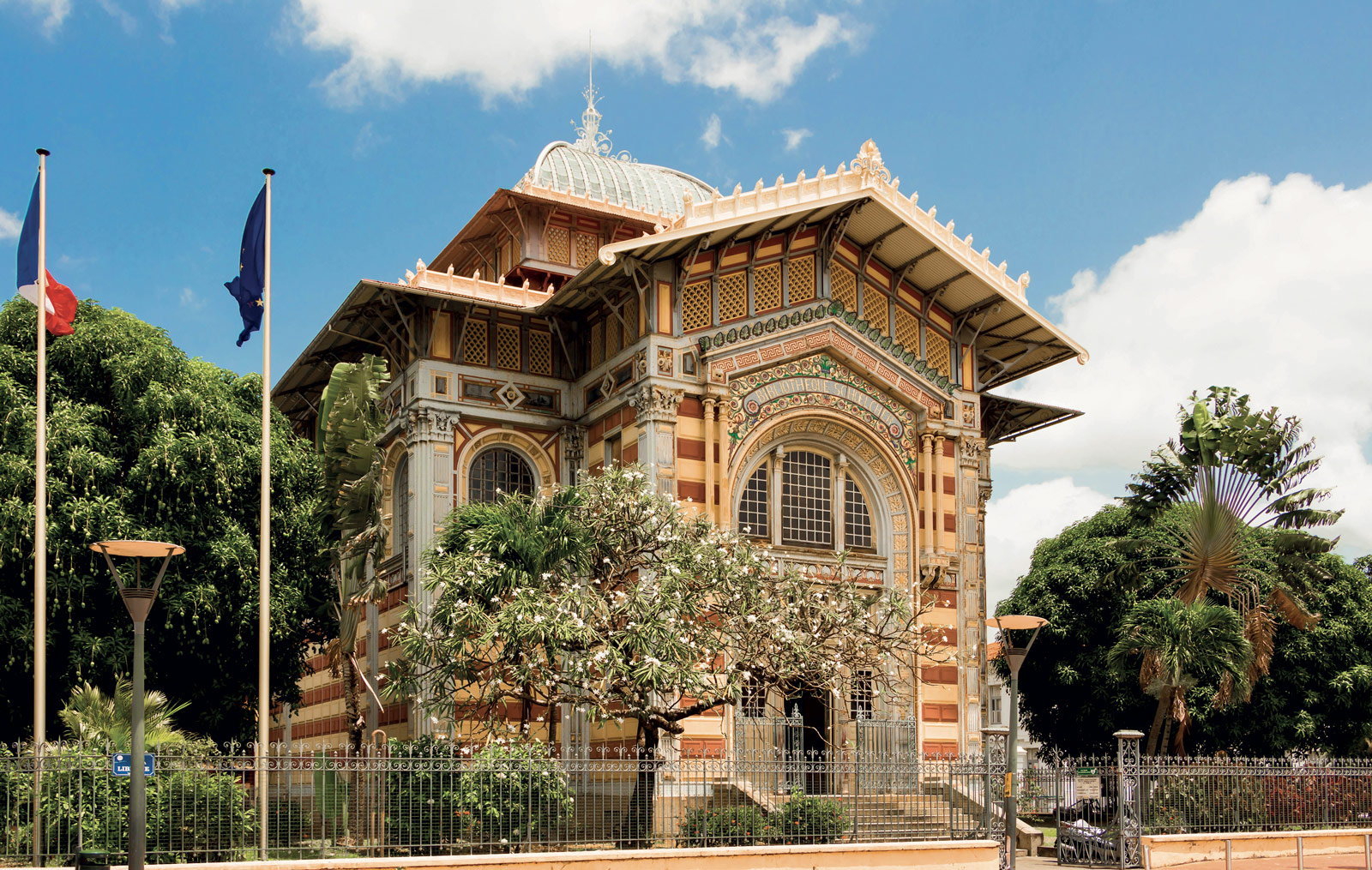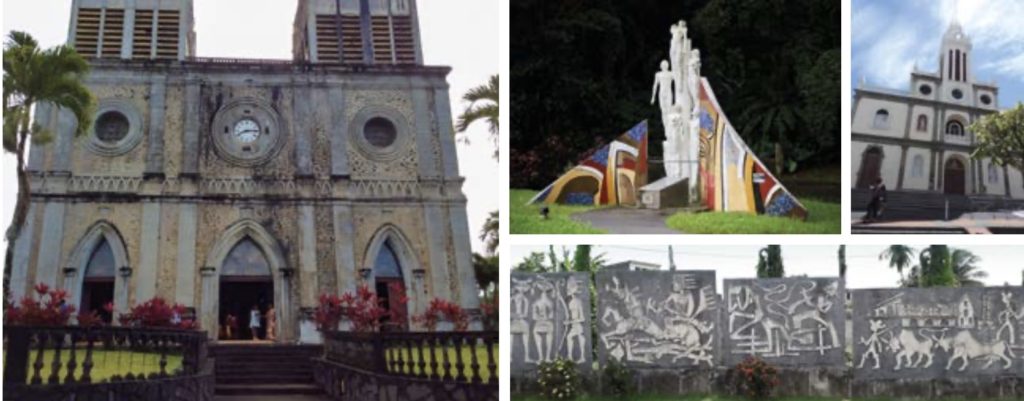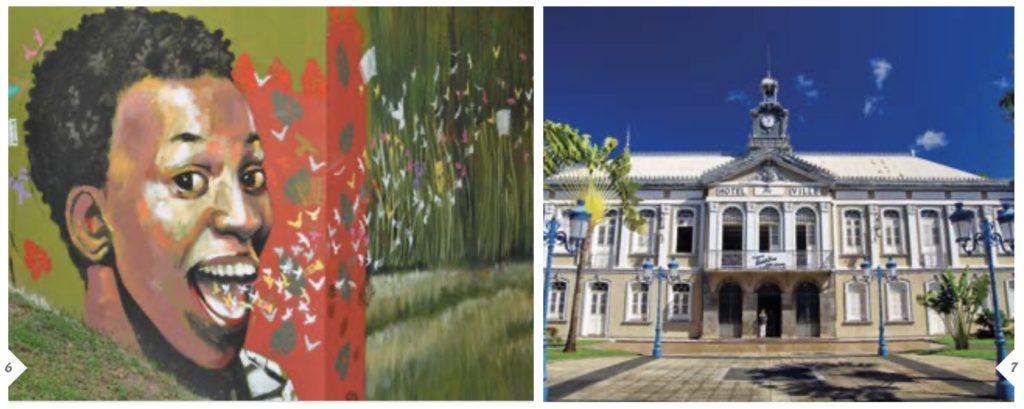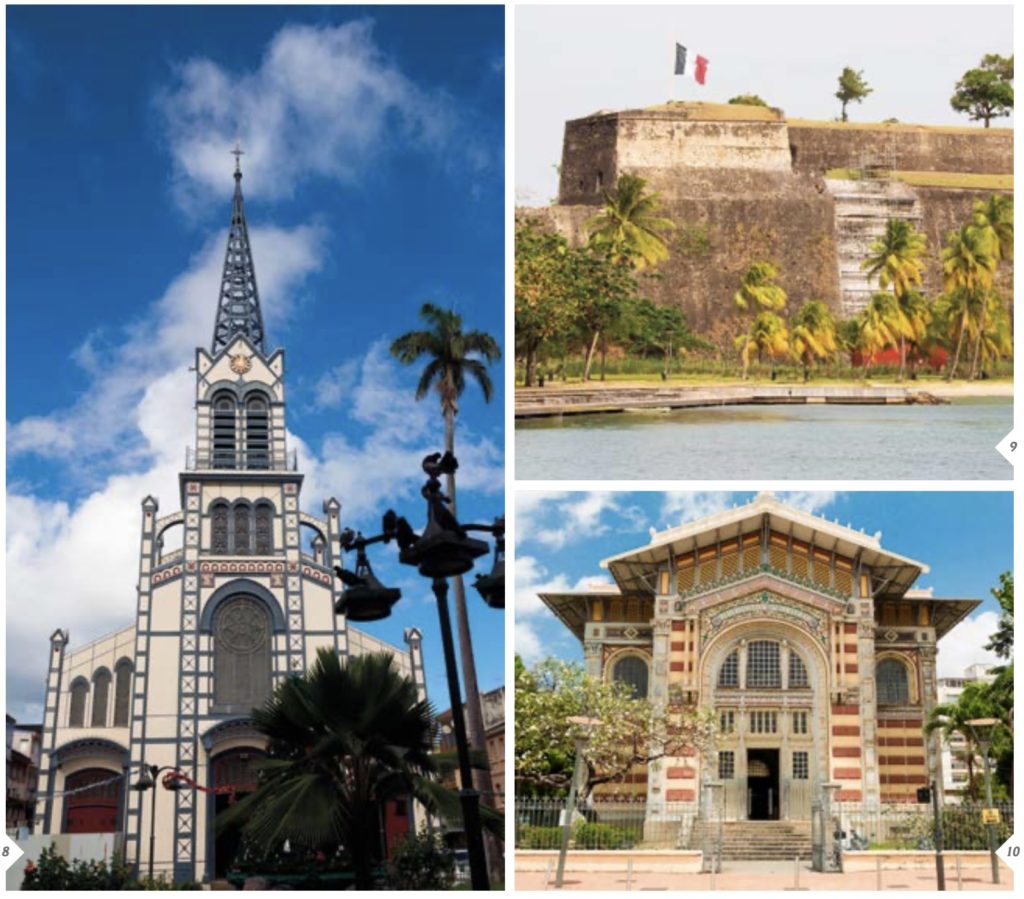
Like many Caribbean islands, Martinique is popular among tourists for its white sandy beaches and lush forests, but for lots more as well. Let’s wander in the center of the island to discover artistic and architectural pearls.
The Center of Martinique opens the island for the World to see, with its ports, airport and cruise terminal. The cities – Fort de France, Le Lamentin, Saint-Joseph and Schœlcher – are proud to be the birthplace or source of inspiration of renowned names in literature: Patrick Chamoiseau, Aimé Césaire, Édouard Glissant, Raphaël Confiant, Marie-Reine de Jaham, Tony Delsham, Georges Mauvois, Frantz Fanon… The Center seems to be fertile ground for the imagination. Let’s enrich ourselves in it.
LE LAMENTIN, A LAND OF CONTRASTS. ~ We start our trip with the largest town in Martinique: Le Lamentin, traversed by La Lézarde, the longest river in Martinique. The island’s economic heart, a shopping and business hub, is also home to many treasures. At one entrance to the large village, a giant, colorful fresco tells the territory’s history. It was painted in 2006 on the cemetery wall by Cuban and Martinican artists for the 10th anniversary of the city’s twinning with Santiago de Cuba. Further on, let’s rest a while on André Aliker square to admire “Le choc des deux mondes” (When two Worlds Collide), a 100-meter mural fresco by artist Khokho René-Corail. Its 13 illustrated white-cement panels retrace the colonial history of the Caribbean and the Americas, starting with the evocation of the Amerindian peoples. Nearby, another story is told by the Saint-Laurent church, erected in the late 17th century. Its stained glass windows are listed as historic monuments. The building also presents an altar in white marble with steps and a tabernacle attributed to Béraud, a marble maker from Le Puy, dating from 1878. On either side of the porch, two monumental canvases by Father Arostéguy (1887- 1956) represent the Resurrection.

SMALL WONDERS IN SAINT-JOSEPH. ~ Bathed by the White River, Saint-Joseph is home to the largest forest area in Martinique. Its church is almost 70m long. It was built in the 19th century and restored during the 20th century, in a basilica style with Gothic influence. Its gigantic size is the result of past streaks of bad luck: the first building was destroyed by a hurricane in 1891 and the second had its roof blown away by the 1903 hurricane. The authorities then decided to build a stronger structure. The result is astonishing. As we leave the town, we discover an aerostela erected in memory of the 152 Martinican people who disappeared in the 2005 air crash on a trip to Panama. Its name, “The Elevation”, is the work of world-renowned Martinican painter and sculptor Hector Charpentier. A dalliance in the forest beckons: don’t resist. Nearby, a cottage welcomes us in.
THE WALLS OF ART IN SCHOELCHER. ~ The next day, we leave Saint-Joseph’s lush vegetation for Schœlcher’s peaceful seashores. It’s the city where Jocelyne Béroard, famous vocalist for the band Kassav, was raised. Here street art is ubiquitous. Walking along the streets here and there you will discover tags and frescoes, some of them absolutely spectacular: the Caribbean fresco at Case Navire produced by artists Caruge and Cauquil, the Amerindian mural at the municipal stadium, artists’ pearls that adorn the area surrounding Arawaks square… A festival of colors executed with great mastery that you will enjoy admiring. It’s well worth staying for a day -and taking the time to also enjoy a peaceful dip in the sea.

STUNNING STYLES IN FORT-DE-FRANCE. ~ On the 3rd day, we head off to Fort-de-France, or “Foyal” as its inhabitants call it. We walk in the footsteps of poet and writer Aimé Césaire, mayor of the city from 1945 to 2001. Shortly before he left, he still occupied his office in the old City Hall, now a municipal theater. The stone, neo-classical building decorated with serrated friezes was opened in 1901. The Italian-style theater hall welcomed and still hosts renowned actors and plays. Listed as a historic monument, it is a remarkable building.
After a few-minutes walk, we end up wide-eyed in front of the special Schœlcher library, facing the Fort-de-France park La Savanne. Constructed of glass and iron, the library combines Art Nouveau with Byzantine, Egyptian and neoclassical influences. It is the work of architect Pierre-Henri Picq, a contemporary of Gustave Eiffel. Built in 1887 in the Tuileries Garden in Paris, it was dismantled, transported by boat and then reassembled in 1893 in Fort-de-France.
The building’s metal skeleton recalls that of the nearby Saint-Louis Cathedral designed by the same architect. Built in 1891, this 66-meter-long, 24-meter-wide cathedral combines neo-Gothic and Romano-Byzantine styles. It has interior floral decoration and several old pieces such as the carved wooden preaching chair from the end of the 19th century. The whole is listed as a historic monument. The stained-glass windows are the work of glass artist Néret and date from the same period. A masterpiece, this cathedral reveals itself in a thousand ways to attentive visitors.

PRESENT HISTORY. ~ We leave this atmosphere of fullness and grandeur to reach the seafront where we schedule a guided tour of the impressive Fort Saint Louis. This French Vauban-style military fort was built in spurts between 1639 and 1710. It’s a rocky promontory almost 600 meters long and 100 meters wide. It was dug, carved and dressed in andesite to rise 40 meters above
the sea. Named “Fort Royal” before 1802, it has retained its military purpose and still houses the headquarters of the French Navy Command in the Antilles. You too can travel back in time through a maze of bastions, bunkers and walkways. We end the visit marveling at Fort de France bay, ranked among the most beautiful bays in the world at the World Travel Market fair in London in 2012.
And then the sun sets. ~ This aesthetic plunge into the island’s heritage deserves more visits as these cities have so much to offer in terms of art and architecture. We can wander in idyllic settings and make small and large detours: Balata Garden in Fort-de-France and nearby the splendid Basilica of the Sacred Heart, the Coeur Bouliki Forest in Saint Joseph, mangroves from Port Cohé to Le Lamentin and scenic views at the waters edge in Schœlcher … They all contribute to creating a wonderful mosaic of landscapes and creations for a contemplative stay.

